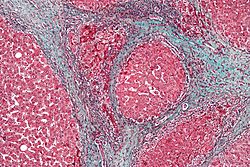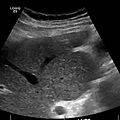Cirrhosis facts for kids
Cirrhosis is a condition in which the liver does not function properly due to long-term damage. Cirrhosis is most commonly caused by alcohol, hepatitis B, hepatitis C, and non-alcoholic fatty liver disease. Typically, more than two or three alcoholic drinks per day over a number of years is required for alcoholic cirrhosis to occur. Diagnosis is based on blood testing, medical imaging, and liver biopsy.
Some causes of cirrhosis, such as hepatitis B can be prevented by vaccination. In severe cirrhosis, a liver transplant may be an option.
Cirrhosis affected about 2.8 million people and resulted in 1.3 million deaths in 2015. Of these, alcohol caused 348,000, hepatitis C caused 326,000, and hepatitis B caused 371,000. In the United States, more men die of cirrhosis than women. The first known description of the condition is by Hippocrates in the 5th century BCE.
Signs and symptoms
Cirrhosis has many possible manifestations. There are also some manifestations whose causes are nonspecific but which may occur in cirrhosis. Likewise, the absence of any signs does not rule out the possibility of cirrhosis. Cirrhosis of the liver is slow and gradual in its development. It is usually well advanced before its symptoms are noticeable enough to cause alarm. Weakness and loss of weight may be early symptoms.
Causes
Liver cirrhosis has many possible causes; sometimes more than one cause is present in the same person. Globally, 57% of cirrhosis is attributable to either hepatitis B (30%) or hepatitis C (27%). Alcohol consumption is another major cause, accounting for about 20% of the cases.
The pathological hallmark of cirrhosis is the development of scar tissue that replaces normal parenchyma. This scar tissue blocks the portal flow of blood through the organ, raising the blood pressure and disturbing normal function. Cirrhosis is generally not reversible.
Imaging
Ultrasound is routinely used in the evaluation of cirrhosis.
Prevention
Key prevention strategies for cirrhosis are population-wide interventions to reduce alcohol intake (through pricing strategies, public health campaigns, and personal counseling), programs to reduce the transmission of viral hepatitis, and screening of relatives of people with hereditary liver diseases.
Treatment
Generally, liver damage from cirrhosis cannot be reversed, but treatment can stop or delay further progression and reduce complications. A healthy diet is encouraged, as cirrhosis may be an energy-consuming process. Close follow-up is often necessary.
Alcoholic cirrhosis caused by alcohol abuse is treated by abstaining from alcohol. Treatment for hepatitis-related cirrhosis involves medications used to treat the different types of hepatitis.
Images for kids
-
Caudate lobe hypertrophy on ultrasound due to cirrhosis
-
Liver cirrhosis on CT imaging of the abdomen in transverse view
See also
 In Spanish: Cirrosis hepática para niños
In Spanish: Cirrosis hepática para niños









